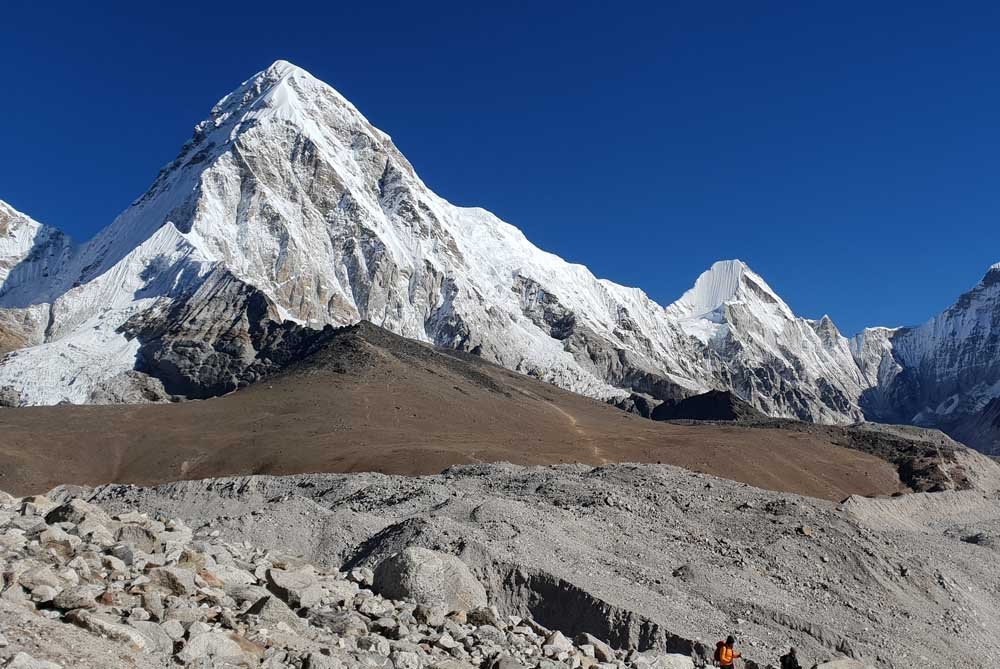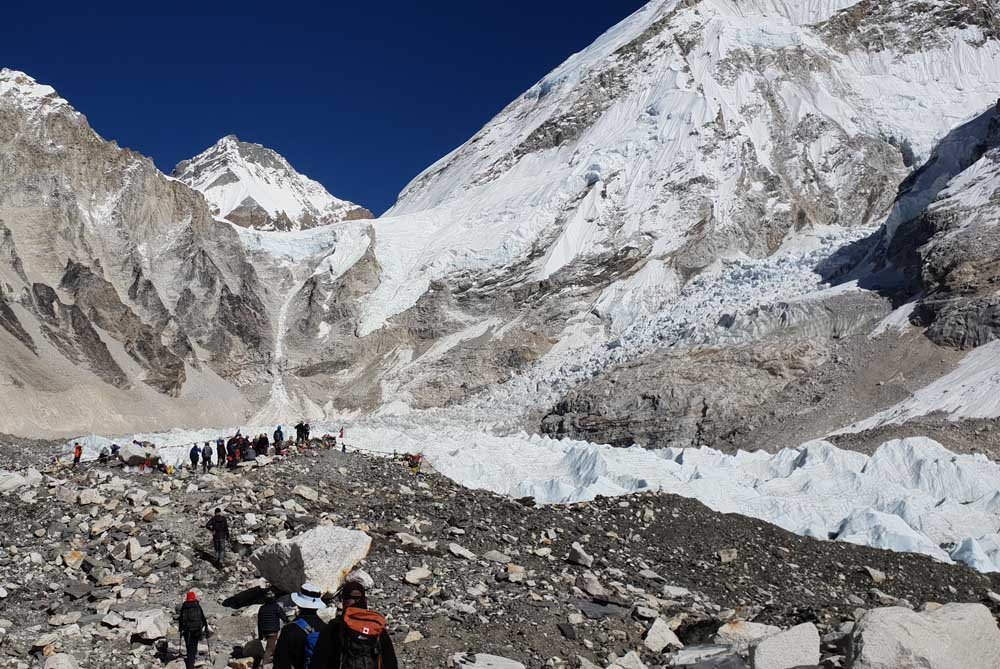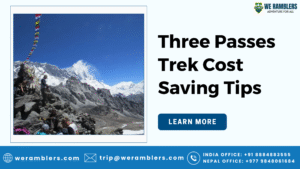Distance Between the Places During Everest Base Camp Trek
The Everest Base Camp Trek is more than just a walk through the Himalayas; it’s an immersive adventure into the heart of Nepal’s Khumbu region, where towering peaks, ancient monasteries, and the Sherpa culture blend into an unforgettable journey. The total Everest Base Camp Trek distance spans around 130 kilometers round trip, beginning and ending in Lukla, a mountain airstrip town reachable by a short but scenic flight from Kathmandu.
From the lush green valleys of Phakding to the arid, glacier-sculpted landscapes of Gorakshep and the rocky terrain around Everest Base Camp, each leg of the route presents a distinct ecological and cultural experience. The trek takes you deep into Sagarmatha National Park, a UNESCO World Heritage Site, and culminates at 5,364 meters, offering up-close views of the Khumbu Icefall and Mount Everest itself. This trek is ideal for those who crave both challenge and serenity, and who wish to witness the grandeur of the Himalayas step by step.
How Long Is the Everest Base Camp Trek
When it comes to understanding how long the Everest Base Camp trek is, it’s important to distinguish between physical distance and actual trekking time. The Everest Base Camp trek length is approximately 65 kilometers from Lukla to base camp, and about 130 kilometers round-trip, not including any optional side hikes or acclimatization excursions.
However, distance alone doesn’t define the trek’s difficulty. The terrain is often rugged, the air thinner with each passing day, and daily altitude gain can have a significant impact on stamina. Most itineraries, including those curated by We Ramblers, space out the journey over 12 to 14 days, allowing ample time for rest and adaptation. By hiking 8 to 15 kilometers per day, depending on the terrain and elevation, trekkers not only manage their energy but also reduce the risk of altitude sickness, making the journey safer and more enjoyable.
Elevation on the Everest Base Camp Trek
Elevation plays a central role in shaping both the experience and challenges of the Everest Base Camp Trek. The adventure begins at a relatively moderate altitude in Kathmandu at 1,400 meters, and gradually ascends to 5,644 meters at Kala Patthar, the trek’s highest viewpoint.
As trekkers gain altitude, they move through multiple ecological zones, from pine forests and rhododendron groves in the lower altitudes to alpine meadows and barren, rocky trails above 4,000 meters. Proper acclimatization is critical because the air gets thinner, carrying less oxygen with each passing meter. Villages like Namche Bazaar and Dingboche are strategically placed not only as rest stops but also as acclimatization hubs, allowing your body to adapt to the changing environment.
These elevation gains are not linear; many days involve a “climb high, sleep low” pattern that helps reduce the risk of Acute Mountain Sickness (AMS). Understanding the Everest Base Camp trek elevation is key to planning your pace and preparing physically for the conditions ahead.
Major Highlights of the Everest Base Camp Trek
The Everest Base Camp Trek is a journey filled with iconic moments and breathtaking scenery. One of the most thrilling parts of the trek is the flight to Lukla, often referred to as one of the most adventurous airstrips in the world.
As you begin trekking, you’ll pass through lush forests, cross roaring rivers over suspension bridges, and encounter villages where prayer wheels spin in the wind.
Namche Bazaar, a bustling Sherpa town, acts as a cultural and commercial hub in the Khumbu region and offers your first glimpse of Mount Everest. Tengboche Monastery, framed by Ama Dablam and other peaks, offers a spiritual break and a chance to witness Buddhist ceremonies at 3,867 meters. Further along, Dingboche and Lobuche offer expansive views of the Himalayan amphitheater, with icy winds and silence replacing the greenery below.

Daily Distances Hiked During the Everest Base Camp Trek
The day-to-day distance and altitude gain of the Everest Base Camp trek varies significantly. Here’s a detailed breakdown of the route, following a typical 14-day itinerary:
Day 1: Arrive at Kathmandu
You’ll land in Nepal’s capital city, Kathmandu, which sits at an altitude of 1,400 meters. This bustling metropolis offers a mix of ancient temples, colorful markets, and modern conveniences. Your first day is all about arrival, rest, and preparation. You’ll meet your trek leader and get a full briefing on the adventure ahead. Overnight in the vibrant tourist district of Thamel.
Day 2: Fly to Lukla and Trek to Phakding
An early morning 35-minute flight takes you to Lukla (2,860 m), the gateway to the Khumbu. From here, your trek begins with a gentle descent through lush forests and picturesque Sherpa villages to Phakding (2,652 m). The distance covered is 7.8 kilometers, usually taking about 3 hours. Along the way, you’ll cross suspension bridges and get your first taste of life in the Himalayas. You’ll stay in a cozy tea house.
Day 3: Phakding to Namche Bazaar
Today is a challenging yet scenic ascent to Namche Bazaar (3,440 m), covering a distance of 10.7 kilometers. The trail follows the Dudh Koshi River, passing through pine forests and crossing several high suspension bridges. The final climb into Namche is steep, but the views of Everest and Lhotse on a clear day are your reward. Expect to walk for 6 to 7 hours before reaching this vital hub for trekkers.
Day 4: Acclimatization at Namche – Hike to Khumjung
This is your first acclimatization day. After breakfast, you’ll hike to Khumjung Village (3,790 m), which is 2.7 kilometers away. It’s a gentle ascent that takes 2 to 3 hours, giving your body time to adapt. Khumjung is one of the largest Sherpa villages in the region and home to the Khumjung Monastery, which claims to house a Yeti scalp. After exploring, you return to Namche for the night.
Day 5: Khumjung to Debuche
Today’s trail winds through rhododendron forests and scenic ridgelines with panoramic views of Ama Dablam, Everest, and Thamserku. You’ll descend slightly to cross the Dudh Koshi River and climb up to Tengboche, home to the famed Tengboche Monastery. After spending some time there, you’ll continue for a short walk to Debuche (3,800 m). The total distance is 8 kilometers, and it takes about 6 to 7 hours to complete.
Day 6: Debuche to Dingboche
This stretch covers 11 kilometers and takes 6 to 7 hours to complete. You’ll pass through the village of Pangboche and gradually climb into the windswept valley of Dingboche (4,410 m). The scenery changes dramatically as trees give way to shrubs and alpine terrain. Dingboche sits in a broad valley with views of Lhotse, Island Peak, and other Himalayan giants. It’s a strategic location for acclimatization and rest.
Day 7: Acclimatization Day at Dingboche
Another critical day for altitude adjustment. You’ll embark on a short 2-hour acclimatization hike to Nagarjun Hill, reaching around 5,000 meters for a brief period before descending. This helps your body prepare for the higher altitudes to come. Dingboche itself is a charming settlement of stone-walled fields and tea houses. Spend the rest of the day resting, journaling, or exploring nearby ridges.
Day 8: Dingboche to Lobuche
Today’s trail leads you past Thukla Pass, a moving site with memorials dedicated to climbers who lost their lives on Everest. The ascent is steady but steep in places. The distance is 8.5 kilometers, and it takes around 6 to 7 hours to reach Lobuche (4,940 m). As you go higher, the terrain becomes more glacial, and the air thinner. The views, however, become increasingly surreal.
Day 9: Lobuche to Gorakshep and Everest Base Camp
This is the day you reach the famed Everest Base Camp (5,364 m). First, you trek to Gorakshep (5,164 m), a settlement nestled on a sandy plain near the Khumbu Glacier. After dropping your gear, you’ll head another 4.1 kilometers to EBC. The round-trip trek for the day totals 12.5 kilometers and can take up to 9 or 10 hours. Standing at base camp, surrounded by ice seracs and prayer flags, is a moment you’ll never forget.
Day 10: Kala Patthar Summit and Trek to Pheriche
Before dawn, you’ll hike to Kala Patthar (5,644 m) for an unforgettable sunrise over Everest. The climb is steep but rewarding. After the summit, you’ll descend to Pheriche (4,371 m), a quieter village perfect for rest. The distance covered is 16 kilometers, with 12 kilometers between Gorakshep and Pheriche. It’s a long day of trekking (8 to 9 hours) but mostly downhill after Kala Patthar.
Day 11: Pheriche to Namche Bazaar
This is one of the longest walking days, covering 19.8 kilometers. The descent takes you through Pangboche, Tengboche, and finally back to Namche Bazaar. The journey takes 6 to 7 hours, and although you’re losing altitude, the impact on the knees and legs is still significant. Namche’s comforts, from fresh bakery items to warm showers and Wi-Fi, feel like a reward after days in remote areas.
Day 12: Namche Bazaar to Lukla
The final trekking day covers 18.5 kilometers as you descend all the way back to Lukla (2,860 m). You’ll pass the checkpoints at Monjo and cross many of the same suspension bridges you did on your way up. The trail is familiar now, and emotions run high as you complete the circuit. The trek takes 6 to 7 hours, with celebrations awaiting at Lukla.
Day 13: Lukla to Kathmandu
If flights operate from Lukla, you’ll board a 35-minute scenic flight back to Kathmandu (1,400 m). In case flights are routed via Ramechhap, a 4.5-hour drive is required to get back to the capital. Once back in Kathmandu, you’ll have time to unwind, shop for souvenirs, or explore the city’s UNESCO sites.
Day 14: Departure
This marks the end of your unforgettable Everest adventure. After breakfast, we will transfer you to Tribhuvan International Airport for your onward journey. The memories, photos, and friendships forged on this trek will last a lifetime.
Why Choose We Ramblers for the Everest Base Camp Trek
At We Ramblers, we go beyond just organizing treks; our team curates experiences that blend adventure with comfort, safety with challenge, and cultural immersion with expert guidance. Our Everest Base Camp trek packages are crafted by seasoned guides, many of whom are native to the Khumbu region and trained in high-altitude first aid.
From arranging Lukla flights and permits to ensuring safe acclimatization schedules, our team handles every logistical aspect. Should emergencies arise, we provide 24/7 evacuation support, keeping your safety as our top priority. Our local connections also ensure better accommodations, honest porters, and culturally sensitive experiences that enrich your journey. Contact us today to get full itinerary details.
Frequently Asked Questions (FAQs)
1. How far is it between camps on Everest?
Between camps on the Everest climb (not trek), distances vary from 1.5 to 3 km, but it’s steep and technical.
2. How far is the Everest Base Camp trek daily distance?
You typically walk 10–15 km per day, depending on the stage and altitude.
3. How far is Gorakshep from EBC?
It’s about 3–4 km one way, taking 2–3 hours to trek.
4. How many kilometers is it to Everest Base Camp?
The full trek from Lukla to EBC and back is around 130 km round trip.





